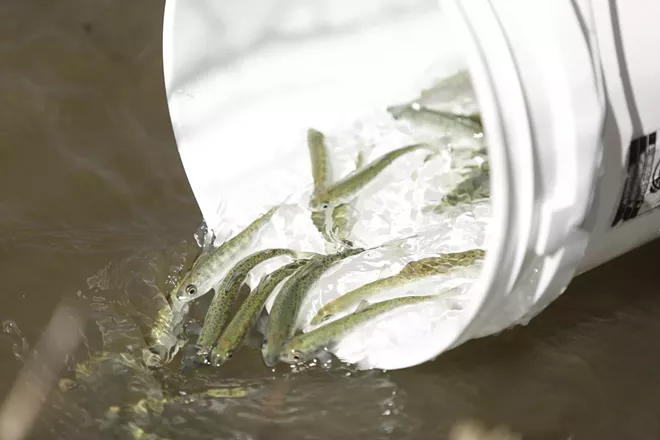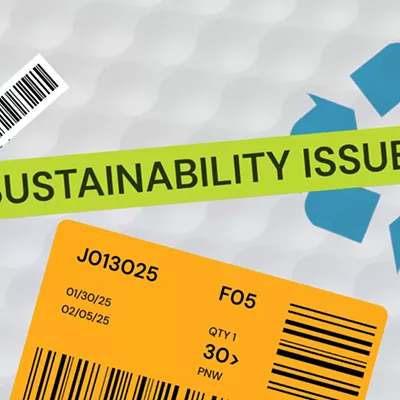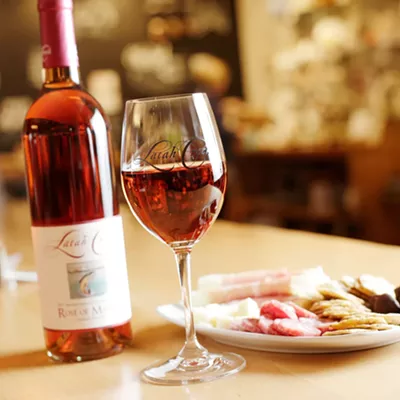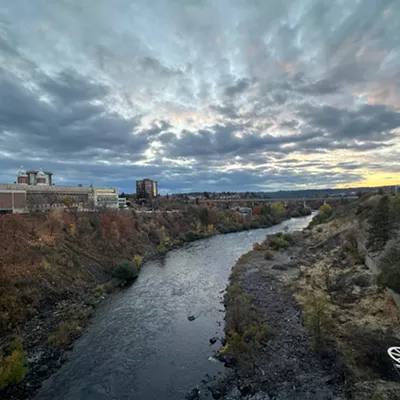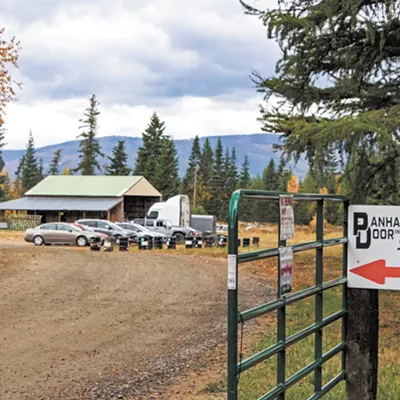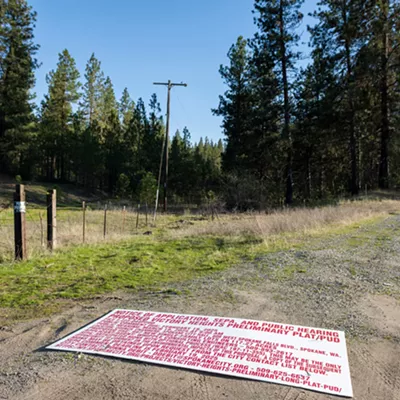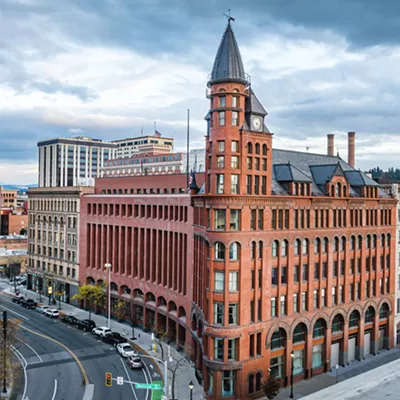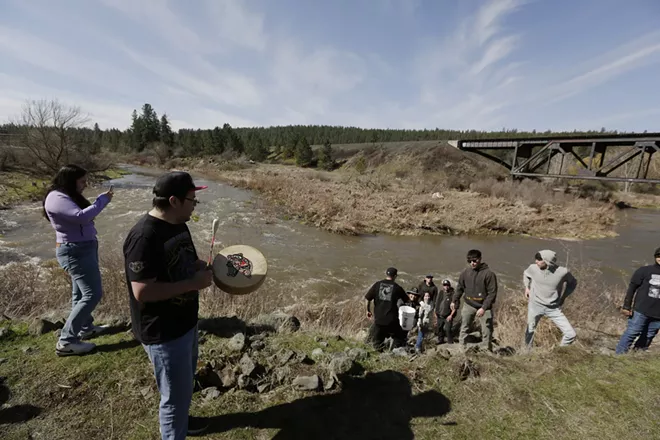
Last year, a chinook salmon completed a journey her immediate ancestors could not.
Raised in a Coeur d'Alene Tribe hatchery and fitted with a pit tag to track her movements, she was released into Hangman Creek about 60 miles south of Spokane near Tensed, Idaho, in 2020. She swam to the Spokane River, down its hydroelectric dams, entered the Columbia, and navigated dozens of miles of warm reservoir and 11 more dams, some of them hundreds of feet high.
Finally, she spilled into the Pacific Ocean.
"It's a huge journey for those fish," says Vince Peone, a Coeur d'Alene tribal member who tracks and harvests salmon for the tribe and surrounding community. "They just come out of the Columbia and head directly north to the Aleutians. They follow the Aleutians around to Japan and across."
When it was time to return, she came home. Or at least, tried to. Her pit tag pinged at fish-ladder-equipped Bonneville Dam, alerting salmon biologists with the Coeur d'Alene Tribe that she was on her way. As she passed Wells Dam — the final upstream-bound blockage salmon can navigate — the Coeur d'Alenes asked the Colville Tribes, who operate the nearby Chief Joseph Hatchery, to watch for her.
"They scanned every fish," says Tom Biladeau, the leading salmon biologist for the Coeur d'Alene Tribe. "And they found her."
It was July 2022. She was assessed for pathogens and appeared free of malady. Peone slipped her into a tank. He drove her in a pickup truck to a riverbank on Hangman Creek, just off U.S. Route 195 in Vinegar Flats. The Tribe had bought the site in 2021 with the idea of building another salmon hatchery, foiling developers' plans for housing on it.
There at Hangman Creek, which is also known as Latah Creek, an assembly of Indigenous and white people awaited the fish's arrival. The fish was placed inside a water-filled tube, which the people passed from one to the next down the bank. At last, the tube reached Peone, who stood waist-deep in the current. Peone pulled the chinook from the tube, held her momentarily toward the sky and slipped her into the creek.
"It was the highlight of my life," says Peone, who claims a spiritual kinship with salmon and fishes for them all over the Pacific Northwest.
The release was a familiar scene of salmon reintroduction in an ongoing partnership between state and federal entities and Inland Northwest Tribes who want salmon to return to the region.
But this event held additional significance as the Coeur d'Alene Tribe hopes to use the site's future hatchery as a research hub to help determine whether salmon can still survive here. That research would be a critical part of a constellation of efforts to return salmon to the Inland Northwest.
The Tribe has drilled two water wells on the property and is contracting with Stantec, an Edmonton-based engineering firm with offices in Spokane, to design the salmon research facility.
But Hangman Creek already contains high levels of phosphorus, Biladeau says. Standing on the site where the facility is planned, he gestures toward algae visible in the water. And fish can add to the phosphorus load, which the Tribe wants to mitigate.
"Water that goes through fish — fish food and fish excrement — has high levels of phosphorus in it," Biladeau says.
Standing on the creek bank near the proposed hatchery site on a clear August day not long after thick wildfire smoke had abated from Spokane skies, Biladeau says the parcel was historically used for agriculture, but could be returned to a wetland, allowing for natural filtration of water. But it also could accommodate more high-tech options like membrane bioreactor treatment similar to what's used at the Spokane Wastewater Treatment Plant in Riverside State Park. Both techniques are options for cleaning the water, but the Tribe is still in the earliest stages of developing the facility and doesn't know which method it will pick. Regardless, it's possible that with treatment, water could reenter the stream healthier than it came out.
"We have to be able to treat that water effectively before it goes back into the system, so it doesn't add to the problem," Biladeau says.
If everything goes well, Biladeau says the hatchery could be operating within four years. But a lot has to happen, including changes in the zoning code that would explicitly allow this sort of aquaculture at the site. The Spokane City Council will discuss the proposed changes three times this month, including at a public hearing on Sept. 25, before deciding whether to allow them.
Marc Gauthier, the wildlife program manager at Upper Columbia United Tribes who personally opposed the housing developments proposed for the site before the Tribe bought it, says the land is important — geographically and geologically — because it was one of only two entries for salmon into what is now Idaho.
"With the natural blockage that Spokane Falls provided, the fish basically had to spawn either at or below the falls or continue up Hangman Creek," Gauthier said. "It's just an extremely important piece of the puzzle."
DEVASTATING DAMS
Before white people arrived in the Inland Northwest, the Spokane and Coeur d'Alene tribes had established gathering places near the property, called "fish camps," to receive the salmon runs. Peone had an older neighbor who had fished in such camps as a child.
"Her grandparents would come from Montana on horse and buggy, and wherever she was staying, if she was staying in Plummer, they would pick her up there," Peone said in a phone interview. "And they would venture clear to Kettle Falls."
They would fish for no less than three or four months, he says. "It was a way of life."
Things changed when white people showed up. They reorganized the ecology, channeled streams, logged forests, mined mountains and, perhaps most devastatingly, built the world's biggest dams at the time.
The first dam, Long Lake Dam on the Spokane River, began operating in 1915. Since then, more dams snaked seaward, and salmon have been (mostly) kept out. The dams, and the ensuing loss of the salmon, constituted a monumental tragedy for Interior Salish Tribes, who'd built entire cultures and trade economies around the fish.
"This loss wounded our region, the Columbia Basin, and even the Pacific Ocean, changing the lands, water, and people, altering ecologies and economies," according to a statement from the Upper Columbia United Tribes.
The importance of salmon is illustrated by the high price the Coeur d'Alene Tribe paid for the 48-acre parcel of stream bank. Located east of the intersection of U.S. Highway 195 and Cheney Spokane Road, it was a "spendy" investment for the Tribe, says Caj Matheson, director of natural resources for the Coeur d'Alene Tribe.
"We're not accustomed to spending $3.2 million on 48 acres," he says, adding "there's no limit to what we will do to make [salmon reintroduction] happen."
"This loss wounded our region, the Columbia Basin, and even the Pacific Ocean, changing the lands, water, and people, altering ecologies and economies."
AN IRONY
The Hangman Creek acreage was previously owned by John Pilcher, a former Spokane city administrator who bought it in 2004 for $290,000 and sat on it for 15 years. In 2019, the city's hearing examiner approved a plan that sought to build 96 homes on the site.
Community activists formed a new organization, the Latah Environment, Agriculture and Fisheries Heritage Project (LEAF), to fight the plan for residential development.
"It felt like they were wedging way too many houses down into that area," said Trevor Finchamp, former president of Friends of the Bluff, a nonprofit that advocates to preserve High Drive Bluff Park, just east of the Hangman Creek property. Finchamp helped to spearhead LEAF.
Local governments had for years explored options to conserve the land, which had been used for farming. Spokane County had prioritized it for its Conservation Futures program, but it could not afford the market value. The city of Spokane also lacked the cash.
LEAF was looking for allies in preventing development on the land and knew it had historically been used by the Coeur d'Alene and Spokane tribes as a gathering place to harvest and celebrate salmon. So members of LEAF contacted both tribes to see if they had interest in helping to prevent single-family homes from being built there. The Coeur d'Alene Tribe decided to buy the property itself and negotiated the multimillion-dollar deal directly with Pilcher.
Still, it seems a bitter historical note that a tribe whose land had been shrewdly whittled away by the U.S. government was now paying market value to buy it back.
"It is an irony," Matheson says.
Finchamp agrees. "I think we all felt a little sheepish about having the tribe pay a cent," he says.
Parcel by parcel, the tribe is reacquiring its land. Much of that land is being purchased, like on Hangman Creek, but the Tribe is also litigating for land and water rights. In 2001, the U.S. Supreme Court ruled in the tribe's favor, granting it ownership of the southern third of Lake Coeur d'Alene.
For many decades, the Tribe's land shrank. That trend is now, slowly, reversing. ♦
KEEP THE DAMS?
Upper Columbia salmon restoration is in Phase 2 of a three-phase plan to study technology that would allow fish to scale the dams, including fish ladders and "salmon cannons," identify viable salmon habitat (researchers have discovered hundreds of river miles), and continue monitoring salmon populations as they trickle back into Inland Northwest watersheds.
Unlike salmon restoration on the Snake and Klamath rivers, these efforts do not seek to demolish dams, which is sensitive political territory. Dams represent cheap, clean, reliable and domestic energy production and are therefore popular. Proposals to demolish them on other heavily regulated rivers face strong opposition that has kept those dams intact.
"One of the challenges that we've had over the years is being able to help individuals understand that we're not talking about removing dams," Matheson told the Spokane Plan Commission in July, when it approved its recommending the zoning amendment to Spokane City Council in July. "Let's get our best scientific minds together and figure out a solution that allows us to have the good energy that the dams provide while at the same time being able to get our fish back, too."
— AARON HEDGE

